This post originally appeared at https://www.badgerinstitute.org/wisconsin-student-enrollment-and-teacher-staffing-trends/
First in a series on the changing world of teachers and teaching

Wisconsin’s public schools are losing students faster than districts are downsizing their staff, analysis of data from the Wisconsin Department of Public Instruction shows.
Statewide, the number of students enrolled in a traditional district-run public school fell to about 791,956 in the 2024-25 school year. The number has been in steady decline since a slight bump in 2013-14 to over 873,500 students, as figure 1 shows. The rate of decline increased after the 2019-20 school year, with a drop of more than 25,000 students
Over nearly the same period, the number of teachers employed in the state has hovered between about 60,000 and 63,000. As figure 2 shows, district-run schools employed 61,652 teachers statewide in 2009-10. That fell by more than 1,600 teachers to 60,003 in 2011-12, but the number then steadily ticked upward to a second peak of 62,398 in 2021-22. For the 2023-24 school year, the latest for which teacher all staff reports are available, there were 61,514 teachers in Wisconsin’s district-run public schools.
As a result, the ratio of teachers to students has generally increased since 1997-98. Figure 3 shows the number of teachers per 100 students in district-run public schools statewide. The rate reached a recent minimum in 2011-12, when it fell to 6.89 teachers per 100 students. The rate has steadily climbed since and reached 7.69 in 2023-24, the highest recorded in the data available.
When districts are divided by size, teacher-to-student ratios tell a more nuanced story. (See figure 4) The average rate of teachers per 100 students is highest among the smallest districts, those with 3,000 students or fewer in the 2023-24 school year. For the 350 or so districts in that bracket, there were an average of 8.58 teachers per 100 students in 2023-24. In 1997-98, that rate was 7.22.
For the 61 medium-sized districts, with between 3,000 and 10,000 students, the rate increased from 6.55 teachers per 100 students in 1997-98 to 7.16 in 2023-24.
Large districts, seven of them between 10,000 and 50,000 students, followed a similar course, rising from 6.61 to 7.61. However, the Milwaukee Public Schools, by far the largest at over 66,800 students in 2023-24, defied the trend. Though it fluctuated over time, its rate was essentially the same in 2023-24 as it was in 1997-98: 5.71 teachers per 100 students.
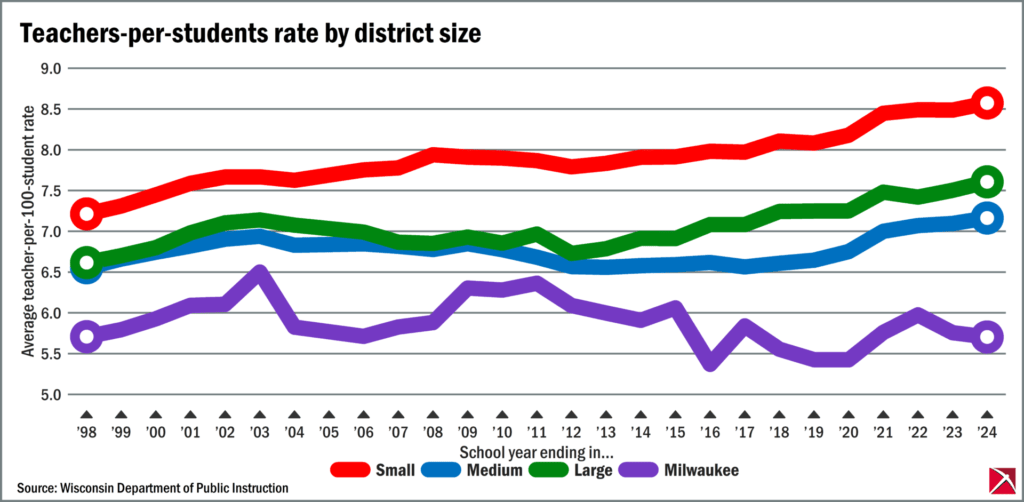
A detailed look at the enrollment and staffing trends for the Milwaukee Public Schools (figure 5) reveals why this is the case. While enrollment has decreased dramatically, from 101,253 in 1998-99 to 66,864 in 2023-24, teacher headcounts have declined at a similar rate from a high of 6,326 in 2002-03 to 3,815 in 2023-24. Thus, the ratio of teachers to students has remained relatively steady.
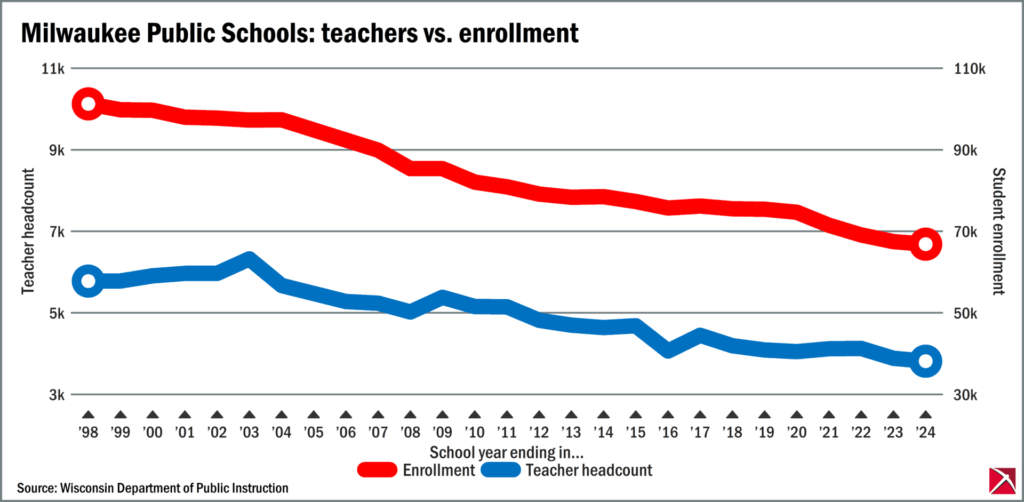
On the other hand, the average small district has had approximately flat teacher headcounts while enrollments have steadily declined. Figure 6 shows the average number of teachers per district in blue, and the average number of students enrolled in red. While the average number of teachers has remained stubbornly above 70 for the average small district, the average number of students has trended downwards from 1,043 to 907. This produces a steadily increasing teacher-per-student rate. The reason for this may be that smaller districts are less able to adjust their staff in response to changing enrollments.
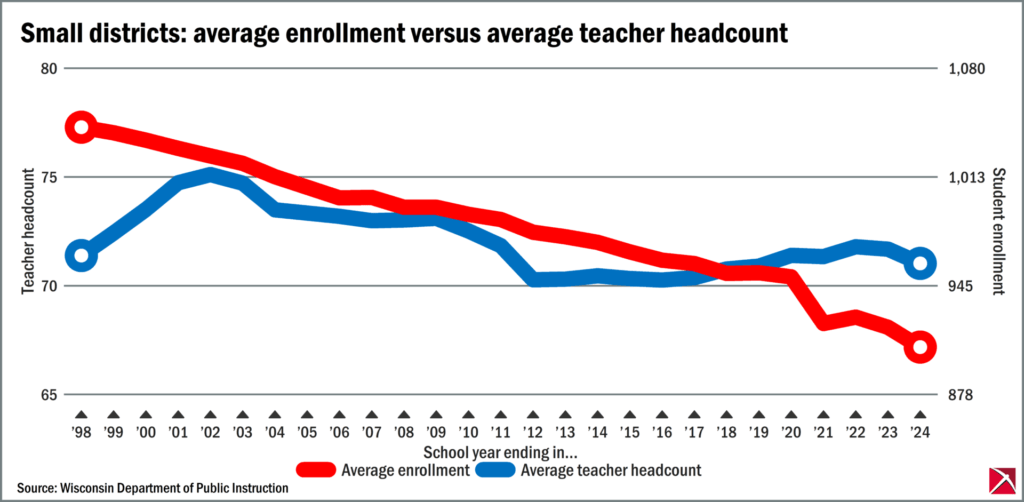
Medium and large districts, on the other hand, generally saw average enrollment increase until the mid-2010s. As figure 7 shows, for medium districts, average enrollment fell after the 2019-20 school year while teacher headcounts continued to rise. For large districts, (figure 8) average enrollment reached its peak in 2013-14, then steadily turned downward, while average teacher headcounts continued to climb until 2017-18. Average teacher headcounts at both medium and large districts have remained elevated relative to enrollment, causing the overall increase in teacher-per-student ratios.
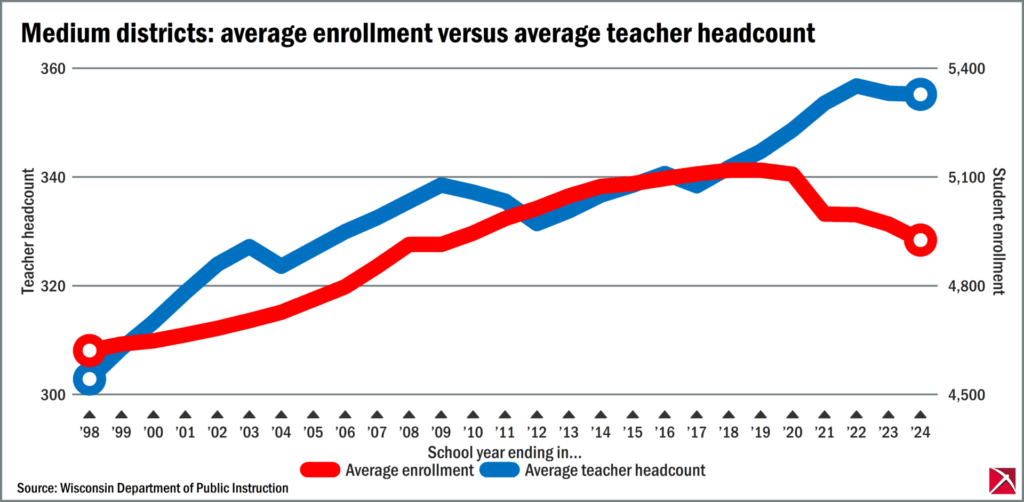
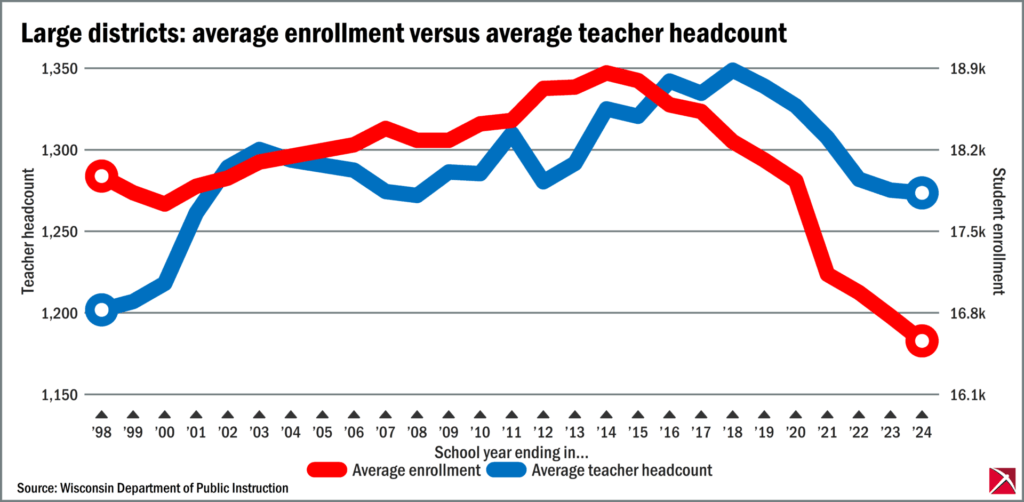
The Badger Institute obtained enrollment data from the DPI’s financial services division, the DPI’s Published Enrollment Data page, and the DPI’s WISEdash data files portal. Data on the numbers of teachers came from the DPI’s Public All Staff reports. For the purpose of this analysis, we counted only students and teachers who belong to standard school districts, omitting independent public charter schools, state-run institutions, and correctional facilities.
The DPI stated in its latest report on the teacher workforce that the largest problem faced by school districts is retaining quality teachers, and future Badger Institute policy briefs will examine that issue in detail.
But if many districts are struggling to provide an adequate teacher workforce, it is in the context of a dwindling student population. Why? Smaller districts may be less able to downsize their staffs, which may have few or a single teacher per grade level. Second, the rate of teachers transferring between districts has increased, a subject we will detail in a later brief. While the statewide teacher count is approximately the same as it was 15 years ago, the pool of teachers available to a particular district, particularly in certain subject areas, may be decreasing.
Wyatt Eichholz is the Policy and Legislative Associate of the Badger Institute.
Any use or reproduction of Badger Institute articles or photographs requires prior written permission. To request permission to post articles on a website or print copies for distribution, contact Badger Institute President Mike Nichols at mike@badgerinstitute.org or 262-389-8239.
var gform;gform||(document.addEventListener(“gform_main_scripts_loaded”,function(){gform.scriptsLoaded=!0}),document.addEventListener(“gform/theme/scripts_loaded”,function(){gform.themeScriptsLoaded=!0}),window.addEventListener(“DOMContentLoaded”,function(){gform.domLoaded=!0}),gform={domLoaded:!1,scriptsLoaded:!1,themeScriptsLoaded:!1,isFormEditor:()=>”function”==typeof InitializeEditor,callIfLoaded:function(o){return!(!gform.domLoaded||!gform.scriptsLoaded||!gform.themeScriptsLoaded&&!gform.isFormEditor()||(gform.isFormEditor()&&console.warn(“The use of gform.initializeOnLoaded() is deprecated in the form editor context and will be removed in Gravity Forms 3.1.”),o(),0))},initializeOnLoaded:function(o){gform.callIfLoaded(o)||(document.addEventListener(“gform_main_scripts_loaded”,()=>{gform.scriptsLoaded=!0,gform.callIfLoaded(o)}),document.addEventListener(“gform/theme/scripts_loaded”,()=>{gform.themeScriptsLoaded=!0,gform.callIfLoaded(o)}),window.addEventListener(“DOMContentLoaded”,()=>{gform.domLoaded=!0,gform.callIfLoaded(o)}))},hooks:{action:{},filter:{}},addAction:function(o,r,e,t){gform.addHook(“action”,o,r,e,t)},addFilter:function(o,r,e,t){gform.addHook(“filter”,o,r,e,t)},doAction:function(o){gform.doHook(“action”,o,arguments)},applyFilters:function(o){return gform.doHook(“filter”,o,arguments)},removeAction:function(o,r){gform.removeHook(“action”,o,r)},removeFilter:function(o,r,e){gform.removeHook(“filter”,o,r,e)},addHook:function(o,r,e,t,n){null==gform.hooks[o][r]&&(gform.hooks[o][r]=[]);var d=gform.hooks[o][r];null==n&&(n=r+”_”+d.length),gform.hooks[o][r].push({tag:n,callable:e,priority:t=null==t?10:t})},doHook:function(r,o,e){var t;if(e=Array.prototype.slice.call(e,1),null!=gform.hooks[r][o]&&((o=gform.hooks[r][o]).sort(function(o,r){return o.priority-r.priority}),o.forEach(function(o){“function”!=typeof(t=o.callable)&&(t=window[t]),”action”==r?t.apply(null,e):e[0]=t.apply(null,e)})),”filter”==r)return e[0]},removeHook:function(o,r,t,n){var e;null!=gform.hooks[o][r]&&(e=(e=gform.hooks[o][r]).filter(function(o,r,e){return!!(null!=n&&n!=o.tag||null!=t&&t!=o.priority)}),gform.hooks[o][r]=e)}});
Submit a comment
“*” indicates required fields
/* = 0;if(!is_postback){return;}var form_content = jQuery(this).contents().find(‘#gform_wrapper_21’);var is_confirmation = jQuery(this).contents().find(‘#gform_confirmation_wrapper_21’).length > 0;var is_redirect = contents.indexOf(‘gformRedirect(){‘) >= 0;var is_form = form_content.length > 0 && ! is_redirect && ! is_confirmation;var mt = parseInt(jQuery(‘html’).css(‘margin-top’), 10) + parseInt(jQuery(‘body’).css(‘margin-top’), 10) + 100;if(is_form){jQuery(‘#gform_wrapper_21’).html(form_content.html());if(form_content.hasClass(‘gform_validation_error’)){jQuery(‘#gform_wrapper_21’).addClass(‘gform_validation_error’);} else {jQuery(‘#gform_wrapper_21’).removeClass(‘gform_validation_error’);}setTimeout( function() { /* delay the scroll by 50 milliseconds to fix a bug in chrome */ jQuery(document).scrollTop(jQuery(‘#gform_wrapper_21’).offset().top – mt); }, 50 );if(window[‘gformInitDatepicker’]) {gformInitDatepicker();}if(window[‘gformInitPriceFields’]) {gformInitPriceFields();}var current_page = jQuery(‘#gform_source_page_number_21’).val();gformInitSpinner( 21, ‘https://e74sq7k37a8.exactdn.com/wp-content/plugins/gravityforms/images/spinner.svg’, true );jQuery(document).trigger(‘gform_page_loaded’, [21, current_page]);window[‘gf_submitting_21’] = false;}else if(!is_redirect){var confirmation_content = jQuery(this).contents().find(‘.GF_AJAX_POSTBACK’).html();if(!confirmation_content){confirmation_content = contents;}jQuery(‘#gform_wrapper_21’).replaceWith(confirmation_content);jQuery(document).scrollTop(jQuery(‘#gf_21’).offset().top – mt);jQuery(document).trigger(‘gform_confirmation_loaded’, [21]);window[‘gf_submitting_21’] = false;wp.a11y.speak(jQuery(‘#gform_confirmation_message_21’).text());}else{jQuery(‘#gform_21’).append(contents);if(window[‘gformRedirect’]) {gformRedirect();}}jQuery(document).trigger(“gform_pre_post_render”, [{ formId: “21”, currentPage: “current_page”, abort: function() { this.preventDefault(); } }]); if (event && event.defaultPrevented) { return; } const gformWrapperDiv = document.getElementById( “gform_wrapper_21” ); if ( gformWrapperDiv ) { const visibilitySpan = document.createElement( “span” ); visibilitySpan.id = “gform_visibility_test_21”; gformWrapperDiv.insertAdjacentElement( “afterend”, visibilitySpan ); } const visibilityTestDiv = document.getElementById( “gform_visibility_test_21” ); let postRenderFired = false; function triggerPostRender() { if ( postRenderFired ) { return; } postRenderFired = true; jQuery( document ).trigger( ‘gform_post_render’, [21, current_page] ); gform.utils.trigger( { event: ‘gform/postRender’, native: false, data: { formId: 21, currentPage: current_page } } ); gform.utils.trigger( { event: ‘gform/post_render’, native: false, data: { formId: 21, currentPage: current_page } } ); if ( visibilityTestDiv ) { visibilityTestDiv.parentNode.removeChild( visibilityTestDiv ); } } function debounce( func, wait, immediate ) { var timeout; return function() { var context = this, args = arguments; var later = function() { timeout = null; if ( !immediate ) func.apply( context, args ); }; var callNow = immediate && !timeout; clearTimeout( timeout ); timeout = setTimeout( later, wait ); if ( callNow ) func.apply( context, args ); }; } const debouncedTriggerPostRender = debounce( function() { triggerPostRender(); }, 200 ); if ( visibilityTestDiv && visibilityTestDiv.offsetParent === null ) { const observer = new MutationObserver( ( mutations ) => { mutations.forEach( ( mutation ) => { if ( mutation.type === ‘attributes’ && visibilityTestDiv.offsetParent !== null ) { debouncedTriggerPostRender(); observer.disconnect(); } }); }); observer.observe( document.body, { attributes: true, childList: false, subtree: true, attributeFilter: [ ‘style’, ‘class’ ], }); } else { triggerPostRender(); } } );} );
/* ]]> */
The post Wisconsin student enrollment and teacher staffing trends appeared first on Badger Institute.



